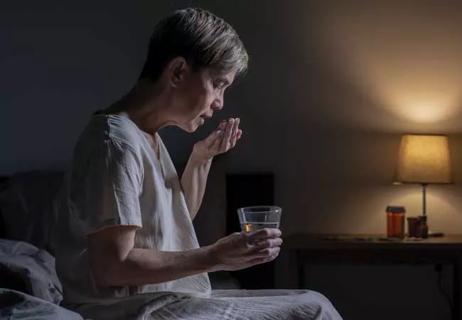A review of IDSA and NIH guidelines

Written by Kathryn Bash, MHSc, MSN, APRN-CNP, Gretchen Sacha, PharmD, BCCCP and Mani Latifi, MD
Advertisement
Cleveland Clinic is a non-profit academic medical center. Advertising on our site helps support our mission. We do not endorse non-Cleveland Clinic products or services. Policy
Note: This article is a slightly abridged version of a review first published in the Cleveland Clinic Journal of Medicine (2023;90(11):677-683). A full version of the open-access article with tables is available here.
What started as a sprint has become a marathon with no end in sight. At three years into the COVID-19 pandemic, the medical community continues to seek answers through research on how to best manage this disease in its spectrum of presentations, and how to translate the answers into evidence-based guidelines. Numerous drugs have been used or considered for use, and as fast as the virus mutated, so did the efficacy and safety of these drugs, as evidenced in trial data.
Treatment recommendations have rapidly evolved and depend on the patient’s medical history, healthcare setting, severity of disease, and other variables. In March 2020, the Infectious Diseases Society of America (IDSA) assembled a multidisciplinary panel to review evidence and make continuing recommendations about treating and managing COVID-19.1 The National Institutes of Health also issued its own guidelines, which are similar but include recommendations for special populations such as those with preexisting medical conditions (including cancer), different age groups, and ethnic groups.2
To date, the IDSA has made 32 recommendations regarding treating COVID-19.1 Many of the recommendations are against using treatments that don’t work, such as hydroxychloroquine. Below, we outline the evidence and recommendations in favor of those that do.
Advertisement
The estimated incubation period for COVID-19 is up to 14 days, and the virus is transmissible two to three days before symptoms start—thus the need for masking and social distancing during outbreaks. Isolation is necessary for all patients with COVID-19.
Most patients experience fever, cough, and shortness of breath.1-3 Like those of many other viral illnesses, these symptoms are nonspecific, and some patients experience atypical symptoms, posing diagnostic challenges.2,4,5
While the numbers have gone up and down,6 as the pandemic grinds through its third year, COVID-19 was responsible for more than 15,000 hospital admissions in the United States in the week of August 13 to August 19, 2023 and for 2.0% of deaths — and these numbers are creeping up at the time of this writing.7 We will need to continue to discover and study the best therapies to mitigate the effects of the pandemic for the foreseeable future.
Although outpatients with COVID-19 generally have milder disease than those admitted to the hospital, some have risk factors for progressing to severe disease.2 It is this group for whom drug treatment is indicated.
SARS-CoV-2, the virus that causes COVID-19, is a ball studded with a “spike” protein, by which it attaches to and merges with the host cell.8 Early in the pandemic, monoclonal antibodies that target the spike protein were shown to have clinical benefits in treating SARS-CoV-2 infection, and the IDSA recommended them for nonhospitalized patients who had mild to moderate COVID-19 but were at high risk of progression to severe disease or death.1 Four products received emergency use authorization from the US Food and Drug Administration to treat adult outpatients with mild to moderate COVID-19: bamlanivimab-etesevimab, casirivimab-imdevimab, sotrovimab, and bebtelovimab.1,2
Advertisement
However, the anticipated activity of the different available antibodies varies dramatically depending on the currently circulating COVID-19 variant. The previously authorized antibodies were not expected to be effective against omicron variants of the virus and therefore are not currently authorized for use.2
Even if the virus has attached itself to the host cell and has gotten in, all is not lost. We can still try to prevent it from replicating and thereby prevent an infection from progressing to more severe disease that could necessitate hospitalization and cause death in patients at high risk. Safe and effective oral agents that do this could help to reduce ongoing strain on healthcare systems and overwhelmed hospital facilities.
Nirmatrelvir-ritonavir is an oral antiviral agent. Nirmatrelvir is a protease inhibitor that targets 3-chymotrypsin-like cysteine protease, an enzyme the virus needs to replicate, whereas ritonavir boosts the activity of nirmatrelvir by inhibiting its metabolism by cytochrome 3A4.
In the Evaluation of Protease Inhibition for Covid-19 in High-Risk Patients (EPIC-HR) trial,9 the largest clinical trial of nirmatrelvir-ritonavir, patients at high risk who were treated within three days of symptom onset had an 89% lower risk of progression to severe critical illness compared with those who received placebo, without any evident safety concerns.9 The IDSA suggests starting this treatment within five days of symptom onset in nonhospitalized patients with mild to moderate COVID-19 at high risk of progression to severe disease.1
Advertisement
Of importance: numerous medications have clinically relevant interactions with nirmatrelvir-ritonavir, particularly several antiarrhythmic agents, anticonvulsants, and psychiatric medications. Additionally, it is imperative to adjust the dosing for patients with moderate renal impairment based on the estimated glomerular filtration rate. Also, as seen in observational studies and in EPIC-HR,9 symptoms can rebound after a course of nirmatrelvir-ritonavir, although the mechanism and frequency remain unclear.
Molnupiravir, another antiviral agent, is approved for outpatient use based on the results of a large clinical trial in unvaccinated patients who had at least one risk factor for severe COVID-19 illness and who could not receive nirmatrelvir-ritonavir, remdesivir, or monoclonal antibodies, in which early treatment (within five days of symptom onset) with molnupiravir reduced the risk of hospitalization and death.10
Nirmatrelvir-ritonavir or molnupiravir should be considered for patients with COVID-19 who are age 65 or older or who are age 12 or older with an underlying condition that increases the risk of severe outcomes of COVID-19. The current recommendations advise against treating patients who have no symptoms or who have symptoms but no high-risk features. There are no recommendations for repeat courses of therapy in patients previously treated with antivirals who experience rebound symptoms.
Given the risk of rebound illness, particularly with nirmatrelvir-ritonavir, the decision to treat should not be based solely on the goal of hastening recovery. Rather, the focus should be on mitigating the risk of progression to severe disease. Patients and prescribers should have a shared medical decision-making discussion to clearly outline the goals of therapy and the risks before starting.
Advertisement
Patients being treated with antivirals in the outpatient setting1 still need to isolate themselves to reduce transmission.
While most COVID-19 cases are either asymptomatic or mild, a substantial percentage of patients develop severe respiratory illness requiring hospitalization.11 Indications for treatment vary depending on severity of illness.1
Remdesivir inhibits viral replication by terminating its RNA transcription, and hopes were high that it would help critically ill patients with COVID-19 who had evidence of hypoxemic respiratory failure. However, four main trials of remdesivir in patients with moderate to severe disease found no significant benefit compared with the standard of care in terms of in-hospital mortality.12 Furthermore, a 2021 study found no clinical benefit from remdesivir in hospitalized patients who had had COVID-19 symptoms for more than seven days and needed oxygen support.13 In a more positive direction, in a 2022 trial in patients with COVID-19 spanning the disease spectrum, fewer patients who received remdesivir needed mechanical ventilation compared with those who did not receive the drug.14
The IDSA recommends that remdesivir be considered in patients with mild to moderate disease who are at high risk of progression to severe COVID-19 and in hospitalized patients with oxygen saturation less than 94% breathing room air, and that it not be considered in those who already need mechanical ventilation or extracorporeal membrane oxygenation.1 When used in those with severe or critical illness, it should be considered an adjunct therapy, given in addition to glucocorticoids (see below).
COVID-19 is associated with diffuse lung injury through an inflammation-mediated response within the lung parenchyma. It is not the infection itself that causes most of the damage but rather the body’s exaggerated reaction to it—the “cytokine storm.”15 Glucocorticoids have long been used to modulate inflammation, and several studies have investigated their use in hospitalized patients with COVID-19.11
Dexamethasone. The Randomized Evaluation of Covid-19 Therapy (RECOVERY) trial11 established dexamethasone as the standard of care in patients with COVID-19. Patients were assigned to receive either dexamethasone 6 mg daily for 10 days or usual care alone. Overall, the mortality rate at 28 days was significantly lower with dexamethasone. However, no difference was detected in the subgroup of patients who did not need supplemental oxygen at baseline. This led the IDSA to recommend that dexamethasone be used only in patients with a pulse oximeter reading of less than 94% on room air or in those requiring supplemental oxygen.11
Because dexamethasone 6 mg was good, further studies sought to determine if 12 mg would be better. It wasn’t. In a trial in patients hospitalized with COVID-19 who needed supplemental oxygen, there was no significant difference in clinical outcomes between the dosing groups, confirming the original dose of 6 mg per day.16 A more recent study looked at the effects of high-dose versus low-dose dexamethasone therapy on all-cause mortality at 60 days, and at the effect of different oxygenation strategies vs standard of care on the need for invasive mechanical ventilation at 28 days.17 The findings suggest that neither make any significant difference in these outcomes.
Interleukin 6 inhibitors
To curb the immune response to COVID-19, in addition to giving steroids, experts began looking at agents that inhibit interleukin 6 (IL-6), a cytokine produced by macrophages that induces an inflammatory response and is often elevated in patients with COVID-19.18 One of the attractions of targeting IL-6 is that approved agents already exist that inhibit either the cytokine itself (anakinra, canakinumab, and rilonacept) or its receptor (tocilizumab and sarilumab). Enthusiasm for these agents was high, although it was unclear whether IL-6 inhibitors were safe in COVID-19, as they make patients more vulnerable to infection.
Several studies of IL-6 inhibitors in hospitalized patients with COVID-19 had positive results and shaped practice: in-hospital mortality was reduced, as was the amount of organ support required.19 As use in practice continued, further studies looked at another outcome, i.e., the patient’s clinical status by day 28 (ranging from discharged to dead), with death as a secondary outcome. Unfortunately, there was minimal difference in either outcome between those receiving tocilizumab vs placebo.19,20 Other trials similarly found no profound effect on the mortality rate.
However, in the RECOVERY trial, tocilizumab use was associated with a lower risk of progression to either mechanical ventilation or death (35% vs 42%).21 This was further supported by a meta-analysis of 27 randomized controlled trials that evaluated IL-6 inhibitors (usually tocilizumab) and found that their use was associated with a lower rate of 28-day all-cause mortality.22
Regarding sarilumab, the largest trial of this agent to date included more than 400 patients with COVID-19 who needed supplemental oxygen or intensive care unit admission. This trial found no difference in clinical outcomes with sarilumab vs placebo, and sarilumab is recommended only if tocilizumab is unavailable.23
In summary, for hospitalized adults with progressive severe COVID-19 (with low oxygen levels requiring supplemental oxygen) or critical illness (requiring mechanical ventilation or in multiorgan failure) who have elevated markers of systemic inflammation, the IDSA suggests giving tocilizumab in addition to the standard of care (i.e., steroids) rather than standard of care alone.1
Baricitinib, an oral selective Janus kinase 1 and 2 inhibitor, is another agent that inhibits the inflammatory response in viral illness.
COV-BARRIER (Study of Baricitinib [LY3009104] in Participants With COVID-19),24 a randomized, double-blind, placebo-controlled trial, analyzed 1,525 hospitalized patients with COVID-19 in 12 countries who had elevations of one or more inflammatory biomarkers. The patients were randomized 1-to-1 to receive a once-daily oral dose of baricitinib 4 mg or placebo in addition to the local standard of care for up to 14 days or until hospital discharge. Standard of care included systemic corticosteroids such as dexamethasone and antivirals such as remdesivir. The trial found no significant reduction in the trajectory of disease progression overall. By day 28, 8% of the patients in the baricitinib group had died compared with 13% in the placebo group, a 38% relative risk reduction. The incidence of serious adverse events, infections, and venous thromboembolic events was similar between the baricitinib group and the placebo group.
In the Adaptive COVID-19 Treatment Trial 2, the combination of baricitinib and remdesivir shortened the time to recovery in hospitalized patients with COVID-19 compared with remdesivir alone. The acceleration to improvement was most pronounced in the patients who were receiving high-flow oxygen or noninvasive ventilation. Of note, when analyzed by severity of disease, the median time to recovery in the noninvasive ventilation or high-flow oxygen delivery group who received combination therapy was 10 days, compared with 18 days in the control group (which was receiving remdesivir alone).25
The recommended dose of baricitinib is 4 mg once a day (adjusted for renal impairment) for up to 14 days or until discharge from the hospital.25
Tofacitinib is another agent of interest in the same class. In the STOP-COVID trial (Study of the Treatment and Outcomes in Critically Ill Patients With COVID-19),26 tofacitinib was associated with a decreased risk of respiratory failure and death. Approximately 80% of participants in each treatment group also received corticosteroids, and thus this trial supports that tofacitinib plus steroids is effective in improving outcomes in hospitalized patients with COVID-19.26
Baricitinib is favored over tofacitinib because it has more data to support its use. However, tofacitinib can be considered if baricitinib is unavailable.26 The IDSA recommends that if tofacitinib is used, it should be in addition to the standard of care for patients hospitalized for severe COVID-19, and that patients should receive at least prophylactic doses of anticoagulants while in the hospital in view of the risk of venous thromboembolism with tofacitinib.1 Moreover, patients who receive Janus kinase inhibitors should not receive tocilizumab or other immunomodulators, owing to inadequate evidence for combined treatment.1,2
In summary, baricitinib and tofacitinib appear to provide the most benefit in those with severe COVID-19 on supplemental or high-flow oxygen support.1
The COVID-19 pandemic is the biggest public health crisis of the 21st century. In addition to the acute symptoms of active illness, the long-term health complications of COVID-19 pose significant challenges.27
The National Institute for Health and Care Excellence defined post-COVID-19 syndrome (“long COVID”) as “signs and symptoms that develop during or after an infection consistent with COVID-19, continue for more than 12 weeks and are not explained by an alternative diagnosis.”28 Up to half—or maybe more—of all COVID-19 survivors experience long COVID symptoms after initial recovery from acute infection. These symptoms include but are not limited to fatigue, muscle pain, palpitations, cognitive impairment, dyspnea, anxiety, chest pain and arthralgia. About one third of these patients experience these lingering symptoms for about two months after their initial infection.29
Currently, no treatments have been shown to prevent the development of or decrease post-COVID-19 syndrome, although trials are ongoing.30
Advertisement

Dynamic modeling improves the accuracy of outcome predictions for ICU patients

Study sheds light on how clinicians addressed their patients’ pain and insomnia during the pandemic

Patients report improved sense of smell and taste

Clinicians who are accustomed to uncertainty can do well by patients

Unique skin changes can occur after infection or vaccine

Will enable patients with long COVID to enroll in national clinical trials

Cleveland Clinic analysis suggests that obtaining care for the virus might reveal a previously undiagnosed condition

Team collaborates to explore effects of genetic mutations to proteins OAS and RNase L